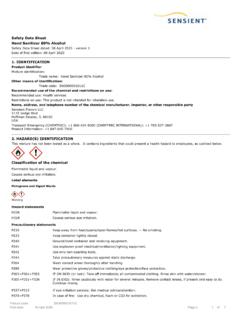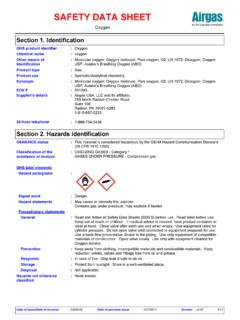Transcription of Safety Data Sheet - Staples Inc.
1 Safety data Sheet Staples Electronics Duster Section 1. Identification Product Identifier Staples Electronics Duster Synonyms SPL35 ENFR-1, SPL35 ENFR-2; SPL07 ENFR-1, SPL07 ENFR-2, SPL07 ENFR- 4, SPL07 ENFR-6, SP07 ENFR-12; SPL10 ENFR-1, SPL10 ENFR-2, SPL10 ENFR-4, SPL10 ENFR-12; SPL07 ENFR80W. Manufacturer Stock N/A. Numbers Recommended use Dust Removal Uses advised against Use Only as Directed - Read label instructions carefully. Keep out of reach of children. Intentional misuse by deliberately concentrating and/or inhaling contents may be fatal. Manufacturer Contact Address Falcon Safety Products, Inc. 25 ImClone Drive Branchburg, NJ, 08876. USA. Phone Emergency Phone Fax (908) 707-4900 (800) 498-7192 N/A. Section 2. Hazards Identification classification FLAMMABLE AEROSOLS - Category 2. GASES UNDER PRESSURE - Compressed gas Signal Word Warning Pictogram Hazard Statements N/A.
2 Precautionary Statements Response N/A. Page 1 of 8. Prevention Do not spray on an open flame or other ignition source. Keep away from heat. Pressurized container: Do not pierce or burn, even after use. Storage Do not store in enclosed vehicle. Protect from sunlight. Store in a well-ventilated place. Store at temperatures not exceeding 120 degrees F/49 degrees C. Disposal N/A. General Keep out of reach of children Ingredients of unknown 0%. toxicity Hazards not Otherwise N/A. Classified No data Available Section 3. Ingredients CAS Ingredient Name Weight %. 75-37-6 Ethane, 1,1-difluoro- 100 %. Occupational exposure limits, if available, are listed in Section 8. Section 4. First-Aid Measures General Advice Never give anything by mouth to an unconscious person. When symptoms persist or in all cases of doubt, seek medical advice. Inhalation Remove from exposure, lie down.
3 Move to fresh air. Keep patient warm and at rest. If not breathing, give artificial respiration. If breathing is difficult, give oxygen. Get immediate medical attention. Skin Take off all contaminated clothing immediately. Flush area with lukewarm water. Do not use hot water. If frostbite has occurred, call a physician. Eye Hold eyelids apart and flush eyes with plenty of water for at least 15 minutes. Get medical attention. Ingestion Is not considered a potential route of exposure. Most important Anaesthetic effects: light-headedness, irregular heartbeat with a strange symptoms/effects, acute and sensation in the chest, heart thumping, apprehension, feeling of fainting, delayed dizziness or weakness. Protection of First-aiders If potential for exposure exists refer to Section 8 for specific personal protective equipment. Notes to Physician Because of possible disturbances of cardiac rhythm catecholamine drugs, such as epinephrine, which may be used in situations of emergency life support, should be used with special caution.
4 Page 2 of 8. Section 5. Fire Fighting Measures Suitable Extinguishing Water spray, water fog, dry chemical, alcohol resistant foam, carbon dioxide Media (CO2). Unsuitable Extinguishing No applicable data available. Media Specific Hazards Flammable. This substance's fire decomposition by-products will include hydrofluoric acid and possibly carbonyl flouride. Avoid contact with these materials, which are toxic and irritating. Evacuate personnel immediately in the event of a fire involving this substance. Vapors may form explosive mixtures with air. Vapors are heavier than air and may spread along floors. Vapors or gases may travel considerable distances to ignition source and flash back. Special protective Use personal protective equipment. Wear neoprene gloves during cleaning up equipment for firefighters work after a fire. Exposure to decompositon products may be a hazard to health.
5 Further Information Use extinguishing measures that are appropriate to local circumstances and the surrounding environment. Cool containers/tanks with water spray. Section 6. Accidental Release Measures NOTE: Review FIRE FIGHTING MEASURES and HANDLING (PERSONNEL) sections before proceeding with clean-up. Use appropriate PERSONAL PROTECTIVE. EQUIPMENT during clean-up. Safeguards (Personnel) Evacuate personnel to safe areas. Ventilate the area. Refer to protective measures listed in sections 7 and 8. Spill Clean-up If this product is spilled and not recovered, or is recovered as a waste for treatment and disposal, the CERCLA Reportable Quantity is 100 lbs. (release of an Unlisted Hazardous Waste with the Characteristic of Ignitability). Evaporates. Ventilate area using forced ventilation, especially low or enclosed places where heavy vapors might collect.
6 Accidental Release Wear self-contained breathing apparatus (SCBA). Measures Page 3 of 8. Section 7. Handling and Storage Handling (Personnel) Avoid breathing vapors or mist. Avoid contact with skin, eyes and clothing. Provide sufficient air exchange and/or exhaust in work rooms. For personal protection see section 8. Handle in accordance with good industrial hygiene and Safety practice. Handling (Physical Aspects) Vapors are heavier than air and may spread along floors. Vapors may form flammable mixture with air. The product should only be used in areas from which all naked lights and other sources of ignition have been excluded. Electrical equipment should be protected to the appropirate standard. No sparking tools should be used. Take measures to prevent the build up of electrostatic charge. Keep away from open flames, hot surfaces and sources of ignition.
7 When using DO NOT SMOKE. Do not use in areas where vapors may accumulate such as paper shredders. Dust Explosion class Not applicable Storage Keep container tightly closed and in a dry, well-ventilated location. Store in original container. The product has an indefinite shelf life when stored properly. Storage Period Recommended shelf life - 10 years provided product is stored in a dry location as directed. Storage Temperature Do not expose to temperatures above 120 degrees F (49 degrees C) as overheating could cause can to burst. DO NOT leave in direct sunlight or enclosed vehicle. Section 8. Exposure Controls/Personal Protection Occupational Exposure Ingredient Name ACGIH TLV OSHA PEL STEL. Limits Ethane, 1,1-difluoro- N/A N/A N/A. Personal Protective N/A. Equipment Engineering controls Ensure adequate ventilation, especially in confined areas. Use respiratory protection if needed.
8 Eye/Face Protection Wear Safety glasses with side shields. Direct contact with liquid may cause frostbite. Respiratory Protection For rescue use self-contained breathing apparatus. Vapors are heavier than air and can cause suffication by reducing oxygen available for breathing. Skin and body protection As required by employer code. If there is risk of skin contact, wear protective clothing, gloves, etc. Direct contact with liquid can cause frostbite. General Hygiene Handle in accordance with good industrial hygiene and Safety practices. Considerations Page 4 of 8. Section 9. Physical and Chemical Properties Physical State Gas Color Clear Odor slight, ether- like Odor Threshold No applicable data available Solubility Water - Slightly Partition coefficient Water/n-octanol N/A. VOC% N/A. Viscosity No applicable data available Specific Gravity Density lbs/Gal Pounds per Cubic Foot N/A.
9 Flash Point <-58 F (<-50 . C). FP Method N/A. Ph Neutral Melting Point No applicable data available Boiling Point -13 F (-25 . C). Boiling Range N/A. LEL UEL Evaporation Rate No applicable data available Flammability Flammable Decomposition Temperature N/A. Auto-ignition Temperature No applicable data available Vapor Pressure 5,960 KPa at 77F (25C). Vapor Density at 77F. (25C) (Air=1). Section 10. Stability and Reactivity Reactivity Stable under recommended storage conditions. Chemical Stability The product is chemically stable under recommended storage conditions. Conditions to Avoid Aerosol containers are unstable at temperatures above 120 degrees F/49. degrees C. Incompatible Materials Incompatible products include Alkali metals, Alkaline earth metals, powdered metals, powdered metal salts. Hazardous Decomposition Decomposition products are hazardous.
10 This material can be decomposed by Products high temperatures (open flames, glowing metal surfaces, etc.) forming hydrofluoric acid and possibly carbonyl fluoride. Page 5 of 8. Section 11. Toxicological Information Component Analysis - LC50 1,1-Difluoroethane - > 64000 ppm rat Component analysis - Oral 1,1-Difluoroethane - 1500 mg/kg rat LD50. Effects of Acute Exposure - Contact with liquid may cause frostbite Eye Effects of Acute Exposure - Contact with liquid may cause frostbite Skin Effects of Acute Exposure - Excessive intentional inhalation may cause respiratory tract irritation and central Inhalation nervous system effect (headaches, dizziness). Vapors may cause dizziness or suffocation. Effects of Acute Exposure - Not a normal route of exposure Ingestion Sensitization Non-hazardous by WHMIS/OSHA criteria. Carcinogenicity Not classifiable as a human carcinogen.











